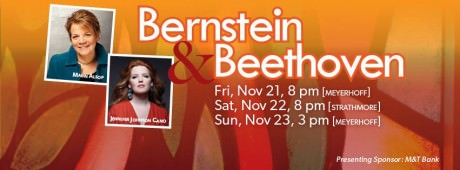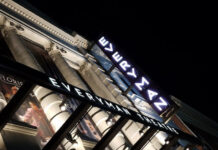Which pieces to put with which on an orchestra program is a subject of endless debate. Does it really matter if concerts have an overall theme? It does if they have as meaningful a connection as the Baltimore Symphony Orchestra’s Bernstein & Beethoven program did on Saturday night at The Music Hall at Strathmore.
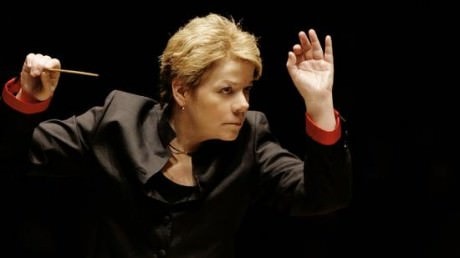
It’s even better if it’s as well (and concisely) explained as conductor Marin Alsop did for the audience. Better still if it’s all performed as beautifully as the BSO did, start to finish.
Leonard Bernstein’s remarkably diverse output included a number of works referencing Biblical texts. One of them is called Chichester Psalms, named after a cathedral in southern England that commissioned the work, and consisting of quotations of parts or all of six psalms. Another is Bernstein’s Symphony #1 – yes, Leonard Bernstein composed three full-length symphonies – which carries the subtitle of “Jeremiah.” The last movement of this symphony contains sung quotations from the Book of Lamentations, attributed to the prophet Jeremiah.
The connection to the entire program? In a remarkably brief and effective 5-minute presentation in between the two Bernstein pieces, Ms. Alsop explained that Bernstein was always deeply affected by all of Beethoven’s output, especially the last movement of his Symphony #9, set to Schiller’s poem Ode to Joy.
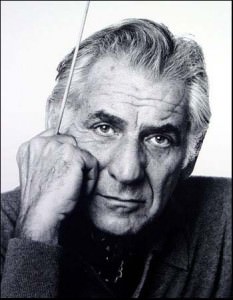
The balance between moods permeates much of Beethoven’s work – the entire Fifth Symphony with its mega-famous “fate knocking on the door” opening in C minor and its transition all the way to its ending in C major has been analogized as the triumph of hope over despair. Maestra Alsop asked the orchestra to play four short segments of Bernstein’s Symphony #1 to demonstrate a similar Beethoven-esque motive of balance among multiple emotions – albeit in Bernstein’s signature mix of 20th century tonally daring “classical” passages and jazz-inflected modalities – before then performing the Bernstein symphony all the way through.
From the start of the concert, a variety of vocal forces were assembled to execute all of the works. For Chichester Psalms, the Cathedral Choral Society from the National Cathedral was employed to sing five of the six psalms in question. Those were psalms 2, 100, 108, 131 and 133 – not necessarily in that order, as Bernstein interleaves passages in meaningful ways throughout the piece.
Singing the original Hebrew, the Cathedral singers leaned into evocative moods established by Bernstein to put these texts into unique contexts. Most notably, Psalm 100, known in church communities by its opening line “Make a joyful noise unto the Lord” and in Jewish liturgy as mizmor l’todah or “song of thanks,” is set against a rollicking rhythm of seven beats to the bar that calls up some of Bernstein’s most jaggedly joyous music from his Broadway shows. This new “twist” on the joyful noise of Psalm 100 (“new” even though it was written in 1965) was, for lack of a better word, a revelation and performed with almost relaxed ease by Ms. Alsop and the BSO.
Psalm 133:1 was sung by the choristers in a sweetly a capella manner, again putting a fresh spin on the line “Behold how good and how pleasant it is for brethren to dwell together in unity,” also a common Jewish anthem in the original Hebrew, Hineh mah tov uma nayim, shevet achim gam yachad.
But the real highlight of Chichester Psalms was solo singing for the most famous text of all – Psalm 23, which calls for a “boy soprano” or quite simply a boy whose voice hasn’t changed yet. Singing against a straightforward orchestral background laid down by the BSO, 11-year-old Nolan Musslewhite of Washington, D.C. delivered a magnificently clean, clear and even heartfelt rendering of the “psalm of David” in Hebrew.
Lest you think this is merely a gimmick, the key to the placement of Psalm 23 in Chichester Psalms with a boy representing “David” is that halfway through the boy’s singing the psalm is interrupted by the adult chorus and orchestra intoning the Hebrew of the strenuous opening lines of Psalm 2, “Why do the nations rage and the people imagine a vain thing?” Having Nolan’s voice come back after the first four verses of Psalm 2 and pick up Psalm 23 at the equivalent of “Thou preparest a table before me in the presence of mine enemies” worked exactly as Bernstein must have envisioned, as a peaceful counterpoint to the rage before it. The very poised Nolan, a student at St. Albans School for Boys, will be fascinating to watch once his voice changes and he takes up new material (if his time as a competitive swimmer and goalie for St. Albans’ lacrosse travel team doesn’t interfere, as the BSO’s charming program notes revealed).
For Bernstein’s Symphony #1, the words of Jeremiah are suggestive in the first two movements and explicitly sung in the third. The BSO’s notably bright sound as opposed to some European orchestras that have recently visited town – with explicit “attacks” on the beginnings of brass notes and a chirping set of woodwinds – came especially into play in the symphony’s second movement, which via instrumental music essentially fulfills Jeremiah’s prophecies of the destruction of Jerusalem in the times of the biblical monarchy.
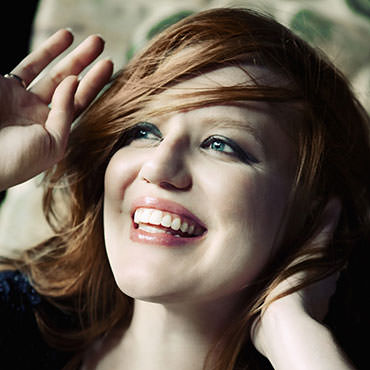
The third movement employed yet another vocal device. Instead of the chorus on stage, a single vocalist, mezzo-soprano Jennifer Johnson Cano, intoned both sad and angry passages from Lamentations following the destruction of Jerusalem. Ms. Cano, who will appear at the Metropolitan Opera later this season in Hansel and Gretel and Les Contes d’Hoffmann, has both a delightful singing instrument and acting chops to spare. That’s no small thing standing alone with only music to guide you. But the alternation of her smile with fist-pounding anger at the variety of Jeremiah’s declarations in Lamentations left nothing to the imagination – even, again, in the original Hebrew rather than English translation.
The BSO returned after intermission with Beethoven’s Symphony #7. Clearly this symphony was selected to impart a final positive note to the evening’s moods. Yet it was still a fitting complement to the drama of the Bernstein music, as a long, four-minute introduction to the first movement, in which Beethoven appears to be “trying out” various moods as chords build and settle first among the woodwinds and then the entire orchestra, finally yields to one of his most popular “up” themes.
Beethoven’s Seventh also has one of the great “slow movements” of all of classical music, an allegretto which magically makes use of repeated notes and lines that barely alternate neighboring notes among the sections to paint a large canvas. It all depends on the phrasing, which Ms. Alsop had no trouble coaxing from her band. She also has a notable way of drawing out the orchestra’s French horns, typically with a large upward sweep of her left hand as if to pull the sonorities up into the Strathmore’s large spaces. If you ever doubt the value of seeing this kind of music performed live as opposed to recorded, this one gesture and how it generates a result is one proof of it.
And not to worry, Beethoven’s two most famous, indeed iconic, symphonies – the Fifth and the Ninth – are both on the BSO’s Strathmore schedule later this season. The roaring appreciation of the crowd at Saturday night’s concert is worth noting because one gets the impression they’ll all be back for those events. Ms. Alsop and the BSO have developed a remarkable following in Montgomery County, with rising subscriptions (hardly the norm in symphony orchestras across the country), buzzing concert halls, and sold-out pre-concert lectures in adjoining rooms at Strathmore. As if to put an exclamation point on the matter, the car ahead of me on exiting the parking garage had a license plate frame that read “Baltimore Symphony Orchestra” as if the BSO is another local sports team. They certainly are doing something right – a peek at this concert was all it took to show why.
Running Time: 2 hours and 10 minutes, with one 15-minute intermission.
Bernstein & Beethoven with the Baltimore Symphony Orchestra was performed on Saturday, November 22, 2014 at The Music Center at Strathmore – 5301 Tuckerman Lane in North Bethesda, MD. For future Baltimore Symphony concerts at Strathmore, check the BSO’s Strathmore concert calendar. For future Strathmore events, check their calendar of events.
https://youtu.be/V6yp9XJfDK0
https://youtu.be/J12zprD7V1k
https://youtu.be/lplcevU_kyo
https://youtu.be/3JS2Plbu1V4


